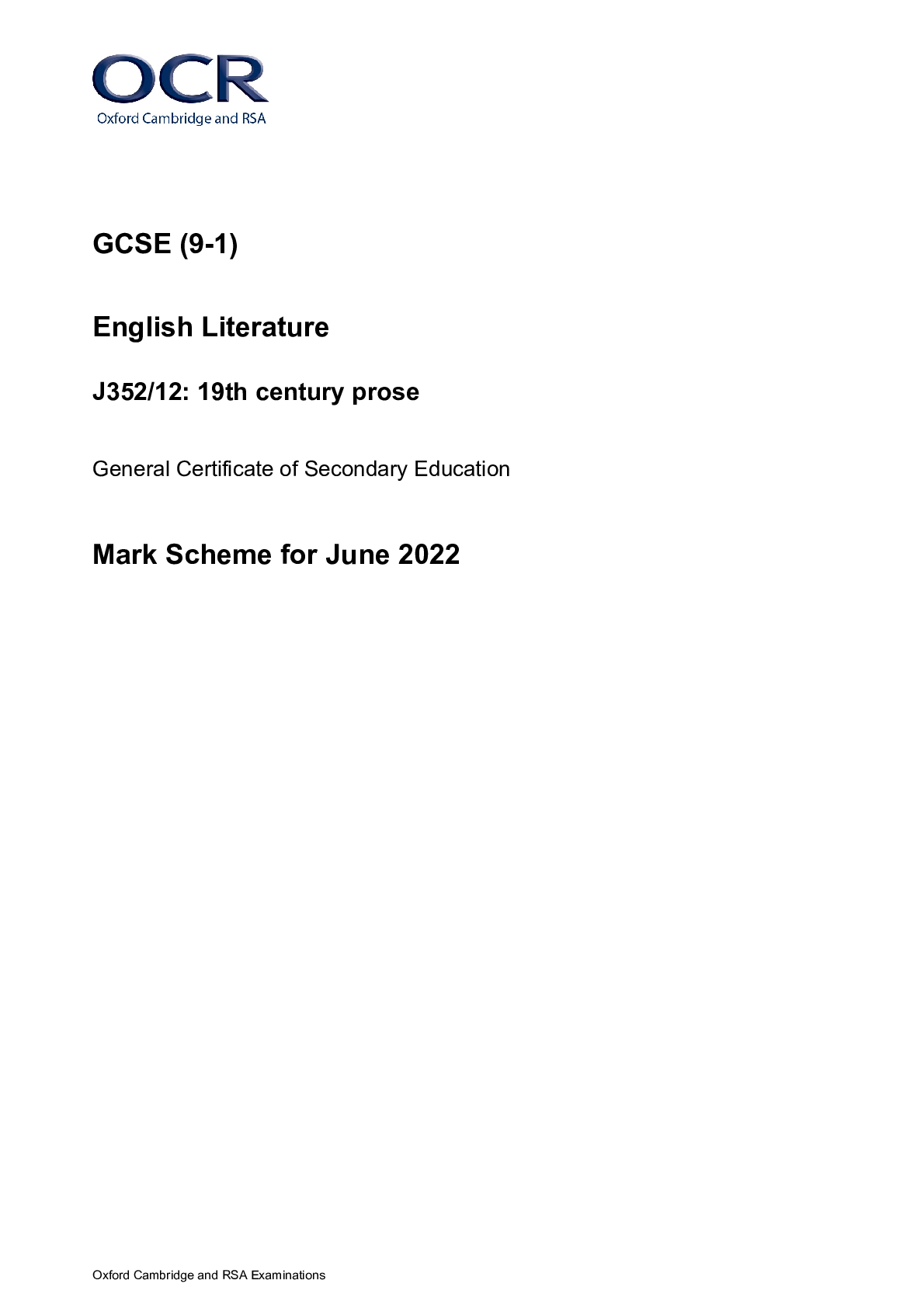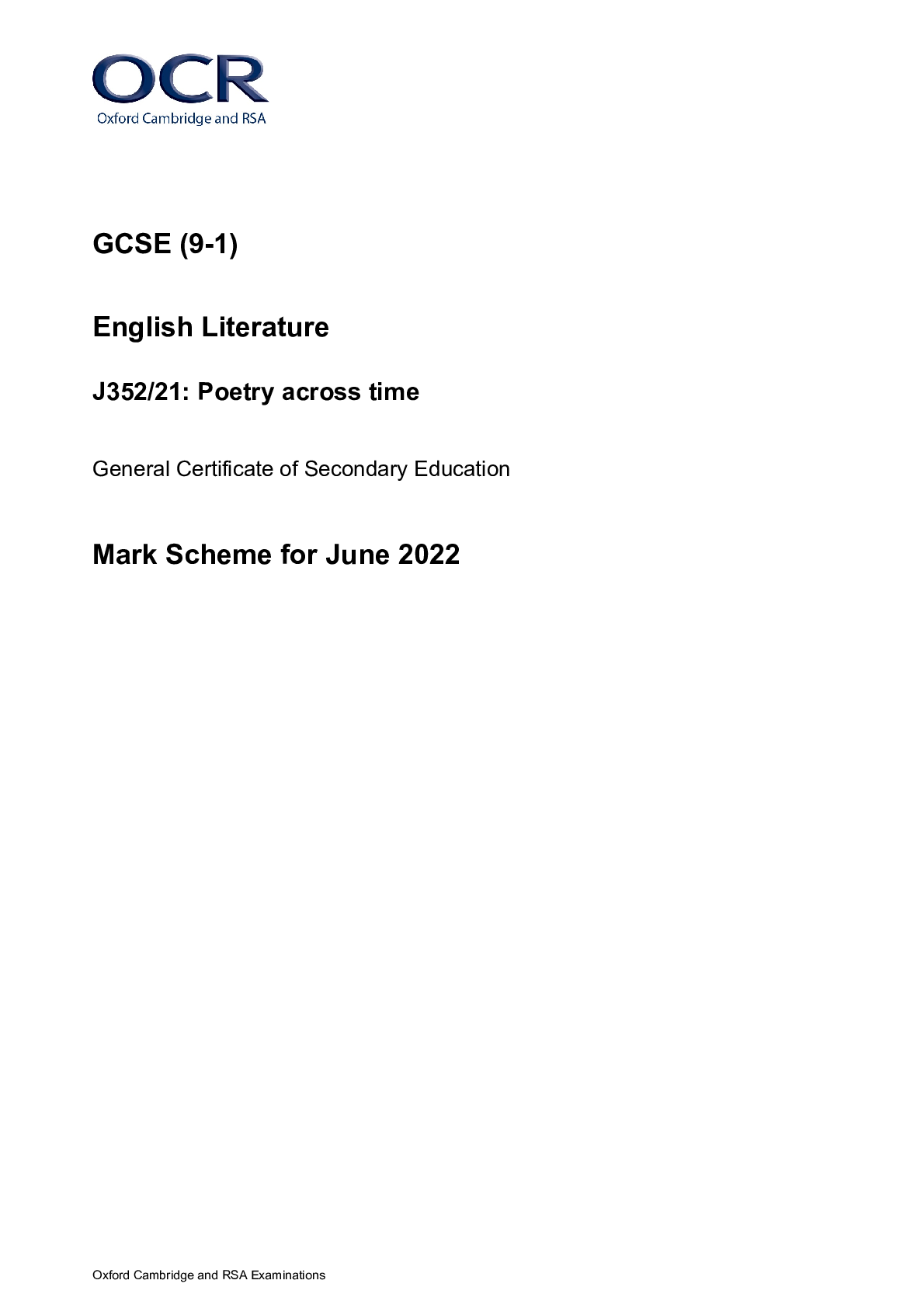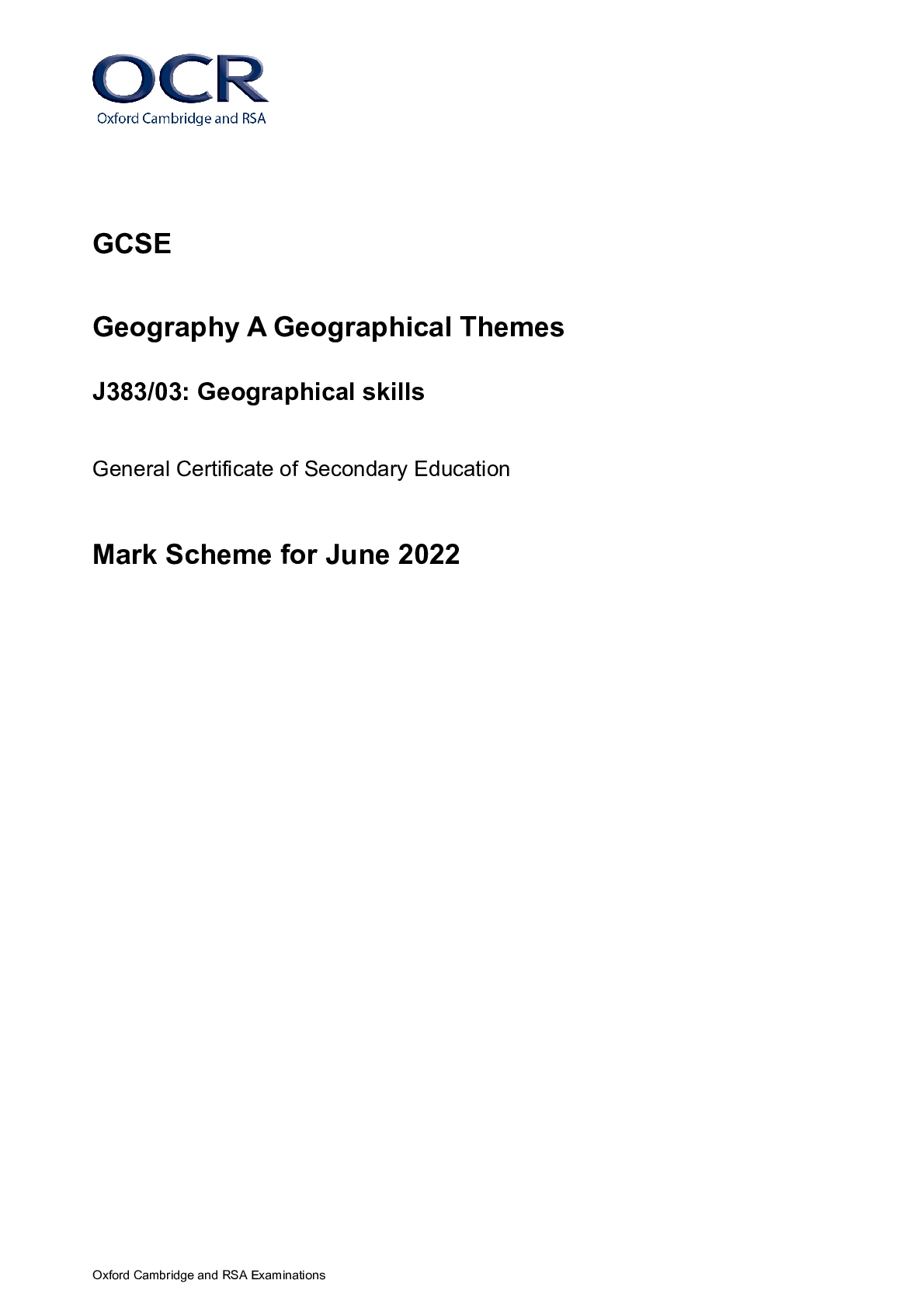Geography > GCSE MARK SCHEME > GCSE (9–1) Geography A (Geographical Themes) J383/01: Living in the UK today General Certificate o (All)
GCSE (9–1) Geography A (Geographical Themes) J383/01: Living in the UK today General Certificate of Secondary Education Mark Scheme for November 2020
Document Content and Description Below
GCSE (9–1) Geography A (Geographical Themes) J383/01: Living in the UK today General Certificate of Secondary Education Mark Scheme for November 2020 Oxford Cambridge and RSA Examinations GC... SE (9–1) Geography A (Geographical Themes) J383/01: Living in the UK today General Certificate of Secondary Education Mark Scheme for November 2020Oxford Cambridge and RSA Examinations OCR (Oxford Cambridge and RSA) is a leading UK awarding body, providing a wide range of qualifications to meet the needs of candidates of all ages and abilities. OCR qualifications include AS/A Levels, Diplomas, GCSEs, Cambridge Nationals, Cambridge Technicals, Functional Skills, Key Skills, Entry Level qualifications, NVQs and vocational qualifications in areas such as IT, business, languages, teaching/training, administration and secretarial skills. It is also responsible for developing new specifications to meet national requirements and the needs of students and teachers. OCR is a not-for-profit organisation; any surplus made is invested back into the establishment to help towards the development of qualifications and support, which keep pace with the changing needs of today’s society. This mark scheme is published as an aid to teachers and students, to indicate the requirements of the examination. It shows the basis on which marks were awarded by examiners. It does not indicate the details of the discussions which took place at an examiners’ meeting before marking commenced. All examiners are instructed that alternative correct answers and unexpected approaches in candidates’ scripts must be given marks that fairly reflect the relevant knowledge and skills demonstrated. Mark schemes should be read in conjunction with the published question papers and the report on the examination. © OCR 2020J383/01 Mark Scheme November 2020 2 Annotations Annotation Meaning Tick Unclear Cross Omission mark Level 1 Level 2 Level 3 Level 4 Development Relevant place detail Benefit of doubt Significant amount of material which doesn’t answer the question Vertical wavy line Communicate findings Blank page Noted but no credit givenJ383/01 Mark Scheme November 2020 3 Subject-specific Marking Instructions INTRODUCTION Your first task as an Examiner is to become thoroughly familiar with the material on which the examination depends. This material includes: • the specification, especially the assessment objectives • the question paper and its rubrics • the mark scheme. You should ensure that you have copies of these materials. You should ensure also that you are familiar with the administrative procedures related to the marking process. These are set out in the OCR booklet Instructions for Examiners. If you are examining for the first time, please read carefully Appendix 5 Introduction to Script Marking: Notes for New Examiners. Please ask for help or guidance whenever you need it. Your first point of contact is your Team Leader.J383/01 Mark Scheme November 2020 4 USING THE MARK SCHEME Please study this Mark Scheme carefully. The Mark Scheme is an integral part of the process that begins with the setting of the question paper and ends with the awarding of grades. Question papers and Mark Schemes are developed in association with each other so that issues of differentiation and positive achievement can be addressed from the very start. This Mark Scheme is a working document; it is not exhaustive; it does not provide ‘correct’ answers. The Mark Scheme can only provide ‘best guesses’ about how the question will work out, and it is subject to revision after we have looked at a wide range of scripts. The Examiners’ Standardisation Meeting will ensure that the Mark Scheme covers the range of candidates’ responses to the questions, and that all Examiners understand and apply the Mark Scheme in the same way. The Mark Scheme will be discussed and amended at the meeting, and administrative procedures will be confirmed. Co-ordination scripts will be issued at the meeting to exemplify aspects of candidates’ responses and achievements; the co-ordination scripts then become part of this Mark Scheme. Before the Standardisation Meeting, you should read and mark a number of scripts, in order to gain an impression of the range of responses and achievement that may be expected. In your marking, you will encounter valid responses which are not covered by the Mark Scheme: these responses must be credited. You will encounter answers which fall outside the ‘target range’ of bands for the paper which you are marking. Please mark these answers according to the marking criteria. Please read carefully all the scripts in your allocation and make every effort to look positively for achievement throughout the ability range. Always be prepared to use the full range of marks.J383/01 Mark Scheme November 2020 5 LEVELS OF RESPONSE QUESTIONS: The indicative content indicates the expected parameters for candidates’ answers, but be prepared to recognise and credit unexpected approaches where they show relevance. Using ‘best-fit’, decide first which set of level descriptors best describes the overall quality of the answer. Once the level is located, adjust the mark concentrating on features of the answer which make it stronger or weaker following the guidelines for refinement. Highest mark: If clear evidence of all the qualities in the level descriptors is shown, the HIGHEST Mark should be awarded. Lowest mark: If the answer shows the candidate to be borderline (i.e. they have achieved all the qualities of the levels below and show limited evidence of meeting the criteria of the level in question) the LOWEST mark should be awarded. Middle mark: This mark should be used for candidates who are secure in the level. They are not ‘borderline’ but they have only achieved some of the qualities in the level descriptors. Be prepared to use the full range of marks. Do not reserve (e.g.) highest level marks ‘in case’ something turns up of a quality you have not yet seen. If an answer gives clear evidence of the qualities described in the level descriptors, reward appropriately.J383/01 Mark Scheme November 2020 6 AO1 AO2 AO3 Comprehensive A range of detailed and accurate knowledge that is fully relevant to the question. A range of detailed and accurate understanding that is fully relevant to the question. Detailed and accurate interpretation through the application of relevant knowledge and understanding. Detailed and accurate analysis through the application of relevant knowledge and understanding. Detailed and substantiated evaluation through the application of relevant knowledge and understanding. Detailed and substantiated judgement through the application of relevant knowledge and understanding. Thorough A range of accurate knowledge that is relevant to the question. A range of accurate understanding that is relevant to the question. Accurate interpretation through the application of relevant knowledge and understanding. Accurate analysis through the application of relevant knowledge and understanding. Supported evaluation through the application of relevant knowledge and understanding. Supported judgement through the application of relevant knowledge and understanding. Reasonable Some knowledge that is relevant to the question. Some understanding that is relevant to the question. Some accuracy in interpretation through the application of some relevant knowledge and understanding. Some accuracy in analysis through the application of some relevant knowledge and understanding. Partially supported evaluation through the application of some relevant knowledge and understanding. Partially supported judgement through the application of some relevant knowledge and understanding. Basic Limited knowledge that is relevant to the topic or question. Limited understanding that is relevant to the topic or question. Limited accuracy in interpretation through lack of application of relevant knowledge and understanding. Limited accuracy in analysis through lack of application of relevant knowledge and understanding. Un-supported evaluation through lack of application of knowledge and understanding. Un-supported judgement through lack of application of knowledge and understanding.J383/01 Mark Scheme November 2020 7 Question Answer Mark Guidance 1 (a) Steep slopes () Highland/mountainous/upland () Wide flat valley bottoms/U shaped valleys/glacial trough () Lake/ribbon lake/reservoir () Rocky/thin soils () Upper course of river () Braided river () Misfit stream/river () Moorland/grassland/forestry () Sparsely populated () 3 3 x 1 () for each valid idea. Each characteristic must be clearly shown in Fig 1 and be typical of a glaciated area. Credit may also be achieved by the development of a description. (b) A type of mass movement () Wet/saturated/unconsolidated/heavy material () moves down slope due to gravity/due to lack of support at the base () along a slip/shear plane () 2 2 x 1 () for each valid idea For two marks to be awarded, reference to the wet/heavy nature of the material must be stated. (c) (i) Traction () the rolling/sliding of large sediment along the sea bed () Saltation () the bouncing of small sediment on the sea bed () Suspension () the transport of small sediment in the body of the waves () Solution () the dissolving of limestone/chalk/soluble sediment into the sea water () Longshore drift () the transport of sediment along the beach ()/by swash and back down the beach by backwash () 2 1 x 1 () for identifying one type of transport 1 x 1 (DEV) for any appropriate description of the chosen type of transport. (ii) Put the numbers in order: 2,4,4,5,5,6,7,8,9,16 () or (5+6)/2 () Find the mean of the middle two values. 5.5 () 2 1x1 () for completing one of the stages in the calculation (eg putting numbers in numerical order) 1x1 () for calculating the medianJ383/01 Mark Scheme November 2020 8 (iii) A crack/weakness/fault in a cliff () is eroded forming a cave. () A cave is eroded through the headland forming an arch. () Eventually the arch falls due to gravity/undercutting/ weathering/erosion leaving a stack. () Further credit can come from the process mechanisms, for example: Abrasion is the sandpapering away of the rock by the sea’s load. () Hydraulic action is the force of the waves on the () when air in cracks is put under pressure by waves () The rock is weakened by weathering () 4 4 x 1 () for each valid explanation of how a stack is formed. Development awarded with () as a further valid explanation. Explanation needs to include geomorphic processes but additional credit can be awarded from the sequence leading to stack formation. Diagram not necessary but credit annotations as appropriate. Do not double credit annotations on the diagram, as well as in the candidate’s written response. Full marks can be awarded for one well-developed explanation. (d) Case Study: one UK coastal landscape Level 3 (5-6 marks) An answer at this level shows thorough knowledge of the impact of human activity on the coastal landscape (AO1) and a thorough understanding of the impact of human activity on the coastal landscape (AO2). This will be shown by including well-developed ideas about the impact of human activity impacts on the coastal landscape. The answer must also include place-specific ideas about the impact of human activity on the coastal landscape. Amount of relevant place-specific detail determines credit within the level. Level 2 (3-4 marks) An answer at this level shows reasonable knowledge of the impact of human activity on the coastal landscape (AO1) and 6 Indicative content: Human activities include: residential, tourism, industrial, agricultural, conservation, coastal management. Responses which are clearly not coastal landscape examples or contexts can achieve a maximum of 3 marks. Discussion about delta and estuarine environments can gain full credit. Discussion may include a range of impacts - positive and negative There is no requirement for responses to evaluate. One human activity with one well-explained impact can gain full marks.J383/01 Mark Scheme November 2020 9 a reasonable understanding of the impact of human activity on the coastal coast or landscape (AO2). This will be shown by developed ideas about the impact of human activity impacts on the coast or coastal landscape. Developed ideas but no place-specific details credited up to bottom of level. Level 1 (1-2 marks) An answer at this level shows basic knowledge the impact of human activity on the coastal landscape (AO1) and a basic understanding of the impact of human activity on the coast or coastal landscape (AO2). This will be shown by simple ideas about the impact of human activity impacts on the coast or coastal landscape. Named example only receives no place-specific detail credit. 0 marks No response worthy of credit. Examples of well-developed ideas: Swanage is located in the county of Dorset, on the South coast of the UK. One important human activity is coastal management. At Swanage there are 21 groynes which trap sediment being transported by longshore drift, which builds up the beach, reducing erosion as the energy of the waves is absorbed. Examples of developed ideas Swanage is located on the South coast of the UK. One important human activity is coastal management. At Swanage there are 21 groynes which trap longshore drift and reduces erosion. Examples of simple ideas One human activity is coastal management. Groynes help to stop erosion.J383/01 Mark Scheme November 2020 10 Question Answer Mark Guidance 2 (a) (i) 0-20 () 1 () (ii) C: 41-60 () 1 () (iii) Fall in the number of 0-20 cohorts might be due to: - Declining birth/fertility rate/having fewer children () - Increasing cost of bringing up children () - Fewer/later marriages () - Increasing equality of opportunity between genders/more women in employment/careers () - Increasing use of/access to contraception () Increases in older cohorts might be due to: - Baby boom generations living through to old age/increasing life expectancy () - Improvements in healthcare () diet () - Changes in employment towards less manual labour () 3 3 x 1 () for points identifying valid reasons for changes in population structure. Development awarded with () as a further valid explanation. Valid reasons may be related to migration and/or natural changes. (b) (i) C: The redevelopment of inner urban areas () 1 () (ii) Business are encouraged to locate in redeveloped areas () As a result new jobs are created in the area () Tax revenues increase () As a result there is more money spent on leisure in the local area boosting the economy () Infrastructure has improved making these areas more accessible () As a result, new businesses have been attracted to these areas () Can lead to a multiplier effect () More people with high levels of wealth (gentrification) () which can make property prices/rents unaffordable () 4 4 x 1 () for valid points identifying economic consequences of re-urbanisation or for explaining the economic consequences identified. Development awarded with () as a further valid explanation. Accept any other suitable economic consequences, including any which are negative. Full marks can be awarded for one well-developed explanation.J383/01 Mark Scheme November 2020 11 (c) Case study: a major city in the UK Level 3 (6-8 marks) An answer at this level demonstrates a reasonable knowledge of the impact of migration and contemporary challenges affecting a city (AO1) with thorough understanding of how migration can impact contemporary challenges affecting a city (AO2). There is a thorough analysis of the impact of migration on contemporary challenges affecting a city (AO3). This will be shown by well-developed ideas about the impacts of the impact of migration on contemporary challenges affecting a city. The answer must also include place-specific ideas about the impact of migration and contemporary challenges affecting a city. Amount of relevant place-specific detail determines credit within the level. There is a well-developed line of reasoning which is clear and logically structured. The information presented is relevant and substantiated. Level 2 (3-5 marks) An answer at this level demonstrates a reasonable knowledge of migration and contemporary challenges affecting a city (AO1) with reasonable understanding of the contemporary challenges affecting a city (AO2). There is a reasonable analysis of the contemporary challenges affecting a city (AO3). This will be shown by developed ideas about migration and/or the contemporary challenges affecting a city. Developed ideas but no place-specific details credited up to bottom of level. 8 Indicative content (including those in the planning phase), including: Migration: This can include any form of migration such international or internal. Housing Provision: This can include affordable housing, housing provision for elderly, student accommodation Waste management: This can include landfill, recycling, waste collection Transport Provision: This can include traffic congestion, overcrowded public transport, cycling. Accept any other relevant challenge in the chosen UK city which results from migration (either in or out). Responses clearly using a LIDC/EDC example or context can achieve a maximum of three marks. Assessment may be implicit and may occur in different forms e.g. Positive/negative points, comparison of challenges/scale, relative to other factors. A conclusion is not a requirement. Examples of well-developed ideas The main migrants to Leeds are students. In term time, there are 30,000 university students living in in the city. Students significantly increase the population of Leeds and increases demand for properties to rent, which means a lack of affordable housing. For example, the average property price in Leeds is £192,000. This means that first-time buyers find it difficult to get onto the housing ladder and people spend a high proportion of their income on rent or mortgage payments.J383/01 Mark Scheme November 2020 12 There is a line of reasoning presented with some structure. The information presented is in the most part relevant and supported by some evidence. Level 1 (1-2 marks) An answer at this level demonstrates a basic knowledge of migration and contemporary challenges affecting a city (AO1) with basic understanding of the contemporary challenges affecting a city (AO2). There is a basic analysis of the contemporary challenges affecting a city (AO3). This will be shown by simple ideas about migration and/or the contemporary challenges affecting a city. Named example only receives no place-specific detail credit. The information is basic and communicated in an unstructured way. The information is supported by limited evidence and the relationship to evidence may not be clear. 0 marks No response worthy of credit. Examples of developed ideas The main migrants to Leeds are students. Students significantly increase the population of Leeds. More students increase the demand for housing, resulting in a lack of affordable housing when buying or renting properties. Examples of simple ideas There are lots of students in Leeds. More people means more housing is needed, making them very expensive.J383/01 Mark Scheme November 2020 13 Question Answer Mark Guidance 3 (a) (i) C: Tropical Continental () 1 () (ii) Highest rainfall occurred in South Wales (), with the lowest occurring in North East/East Wales () (COM). Highest rainfall occurred in upland areas (), with the lowest occurring in lowland areas () (COM). 3 2 x 1 () for describing the pattern rainfall 1 x 1 (COM) for communicating the answer in an appropriate and logical order (will make reference to two elements of the pattern, e.g. high and low rainfall). Evidence from the map is not required. However, references to regions/counties/mountain regions of Wales can be credited as parts of the pattern. (iii) Tropical/polar/Arctic maritime air mass can bring high levels of precipitation: It travels over the ocean () picks up moist air/causing evaporation (). Low pressure develops/the air rises and cools () and condenses into clouds and precipitation (). The polar/tropical continental air mass can cause low levels of precipitation: It travels over land () and does not pick up any moisture (). High pressure develops/cool air descends and warms () and dries out leading to fewer clouds (). 4 4 x 1 () for valid points identifying extreme precipitation linked to an air mass(es) and explaining how this/these causes extremes of precipitation. Development awarded with () as a further valid explanation. Accept any other suitable responses, including any extreme of precipitation such as snow, hail and frost. Full marks can be awarded for one well-developed explanation or developed explanations of more than one air mass. (b)* Case study: a UK flood event caused by extreme weather Level 4 (10-12) An answer at this level demonstrates comprehensive knowledge of the management of the flood event at a variety of scales (AO1) with a comprehensive understanding of the management at a variety of scales (AO2). There will be a comprehensive evaluation of the effectiveness of management at a variety of scales 12 Indicative content Management at a variety of scales could include: Prevention (Dams, flood walls/embankments, afforestation etc) Planning (Land use zoning) Prediction (Environment Agency, Met Office forecasts and warnings) Response (local/UK government, emergency rescue, temporary accommodation)J383/01 Mark Scheme November 2020 14 (AO3) with a comprehensive judgement of the effectiveness of the management (AO3). There will be well-developed ideas about the management at a variety of scales and which are most effective. The answer must also include place-specific ideas about the named flood event caused by extreme weather. Amount of relevant place specific detail determines credit within the level. There is a well-developed line of reasoning which is clear and logically structured. The information presented is relevant and substantiated. Level 3 (7-9 marks) An answer at this level demonstrates thorough knowledge of the management of the flood event at a variety of scales (AO1) with a thorough understanding of the management at a variety of scales (AO2). There will be a thorough evaluation of the effectiveness of management at a variety of scales (AO3) with a thorough judgement of the effectiveness of the management (AO3). This will be shown by including well-developed ideas about management at a variety of scales and/or which are most effective. The answer must also include place-specific ideas about the flood event caused by extreme weather conditions. Amount of relevant place-specific detail determines credit within the level. Scales may be implicit and either spatial (local, regional or national) or temporal (eg short-term emergency rescue versus long-term afforestation schemes). Credit management taking place before, during or after the flood event. Responses about coastal management can achieve full marks. Example of well-developed ideas Storm Desmond occurred in December 2015 resulting in 300mm of rainfall in 24 hours, causing significant flooding in Cumbria. A flood embankment has been built along Warwick Road in Carlisle using funding from the UK government. This increases the capacity of the channel in order to stop water overflowing onto the road, which contains houses and businesses. Although this helps residents in this area, this just transfers the flood risk to communities downstream. Cumbria County Council provides grants for flood resilience schemes. Appleby Guides were given a grant of £2,000 to install removable flood gates on the Guide Hut. The flood gates are placed in front of the doors. This prevents water from getting into the building. These are more effective as people can react to flood risk more effectively and are cheaper than large scale flood walls but does not prevent flooding itself. Example of developed ideas Storm Desmond occurred in December 2015 causing flooding.J383/01 Mark Scheme November 2020 15 There is line of reasoning presented with some structure. The information presented is in the most-part relevant and supported by some evidence. Level 2 (4-6 marks) An answer at this level demonstrates reasonable knowledge of the management of the flood (AO1) with a reasonable understanding of the management (AO2). There will be a reasonable evaluation of the effectiveness of management (AO3) with a reasonable judgement of the effectiveness of the management (AO3). This will be shown by including developed ideas about the management and/or which are most effective. Developed ideas but no place-specific details credited up to middle of level. The information has some relevance and is presented with limited structure. The information is supported by limited evidence. Level 1 (1-3 marks) An answer at this level demonstrates basic knowledge of the management of the flood event (AO1) with a basic understanding of the management (AO2). There will be a basic evaluation of the effectiveness of management (AO3) with a basic judgement of the effectiveness of the management (AO3). This will be shown by including simple ideas about the management. An embankment has been built along Warwick Road in Carlisle. This lets the river hold more water to prevent it flowing onto the floodplain and flooding houses. Cumbria County Council has given grants for flood resilience schemes. A local group were given a grant to install removable flood gates on the building. This prevents water from entering the building. Example of simple ideas Storm Desmond caused flooding. An embankment in Carlisle lets the river hold more water. People are encouraged to protect their properties to reduce the effects of flooding.J383/01 Mark Scheme November 2020 16 Named example only receives no place-specific detail credit. The information is basic and communicated in an unstructured way. The information is supported by limited evidence and the relationship to evidence may not be clear. 0 marks No response worthy of credit. Spelling, punctuation and grammar and the use of specialist terminology (SPaG) are assessed using the separate marking grid in Appendix 1. 3J383/01 Mark Scheme November 2020 17 Appendix 1 Spelling, punctuation and grammar and the use of specialist terminology (SPaG) assessment grid High performance 3 marks • Learners spell and punctuate with consistent accuracy • Learners use rules of grammar with effective control of meaning overall • Learners use a wide range of specialist terms as appropriate Intermediate performance 2 marks • Learners spell and punctuate with considerable accuracy • Learners use rules of grammar with general control of meaning overall • Learners use a good range of specialist terms as appropriate Threshold performance 1 mark • Learners spell and punctuate with reasonable accuracy • Learners use rules of grammar with some control of meaning and any errors do not significantly hinder overall • Learners use a limited range of specialist terms as appropriate 0 marks • The learner writes nothing • The learner’s response does not relate to the question • The learner’s achievement in SPaG does not reach the threshold performance level, for example errors in spelling, punctuation and grammar severely hinder meaningOCR (Oxford Cambridge and RSA Examinations) The Triangle Building Shaftesbury Road Cambridge CB2 8EA OCR Customer Contact Centre Education and Learning [Show More]
Last updated: 1 year ago
Preview 1 out of 19 pages

Reviews( 0 )
Document information
Connected school, study & course
About the document
Uploaded On
Oct 07, 2022
Number of pages
19
Written in
Additional information
This document has been written for:
Uploaded
Oct 07, 2022
Downloads
0
Views
62



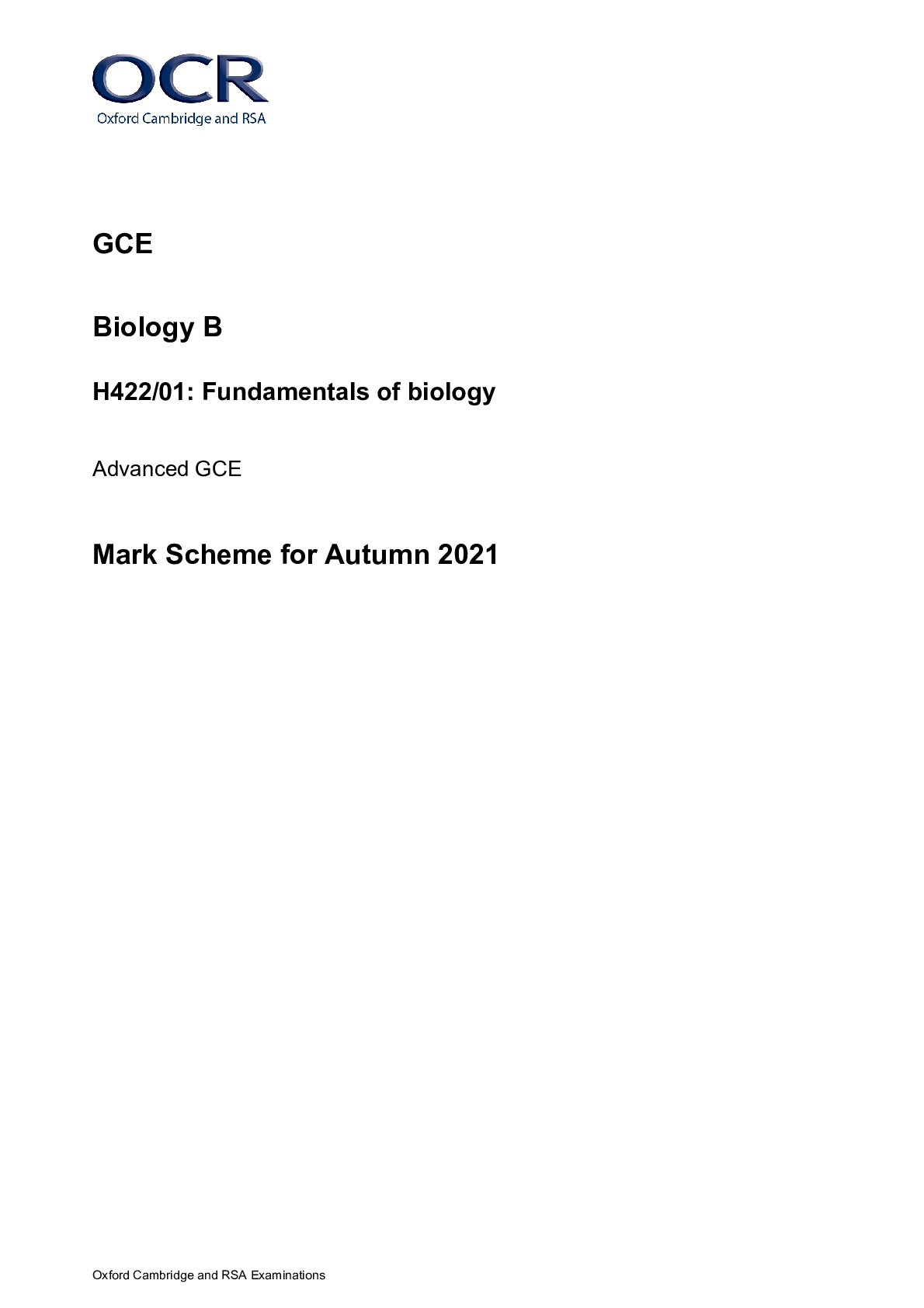
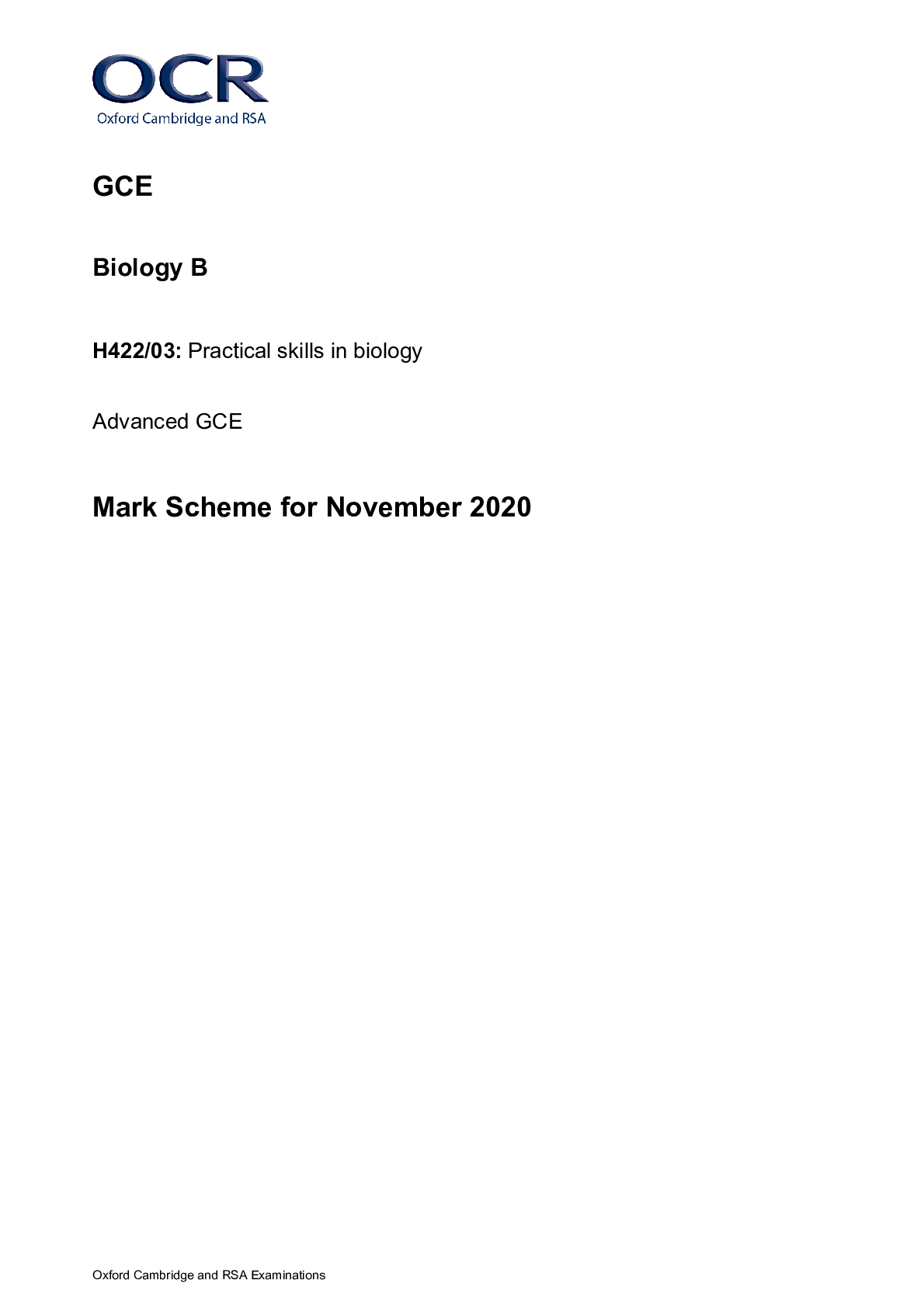
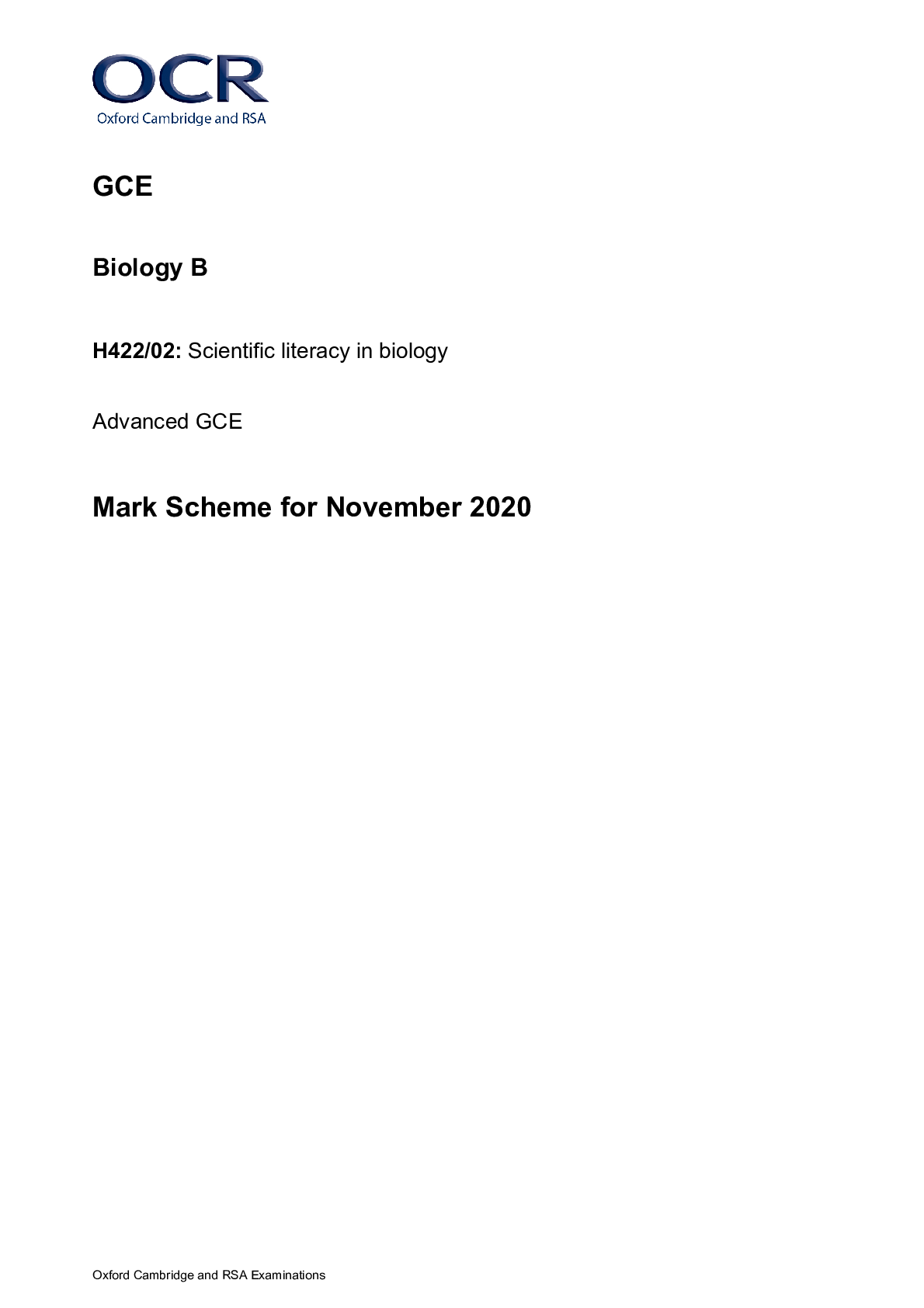
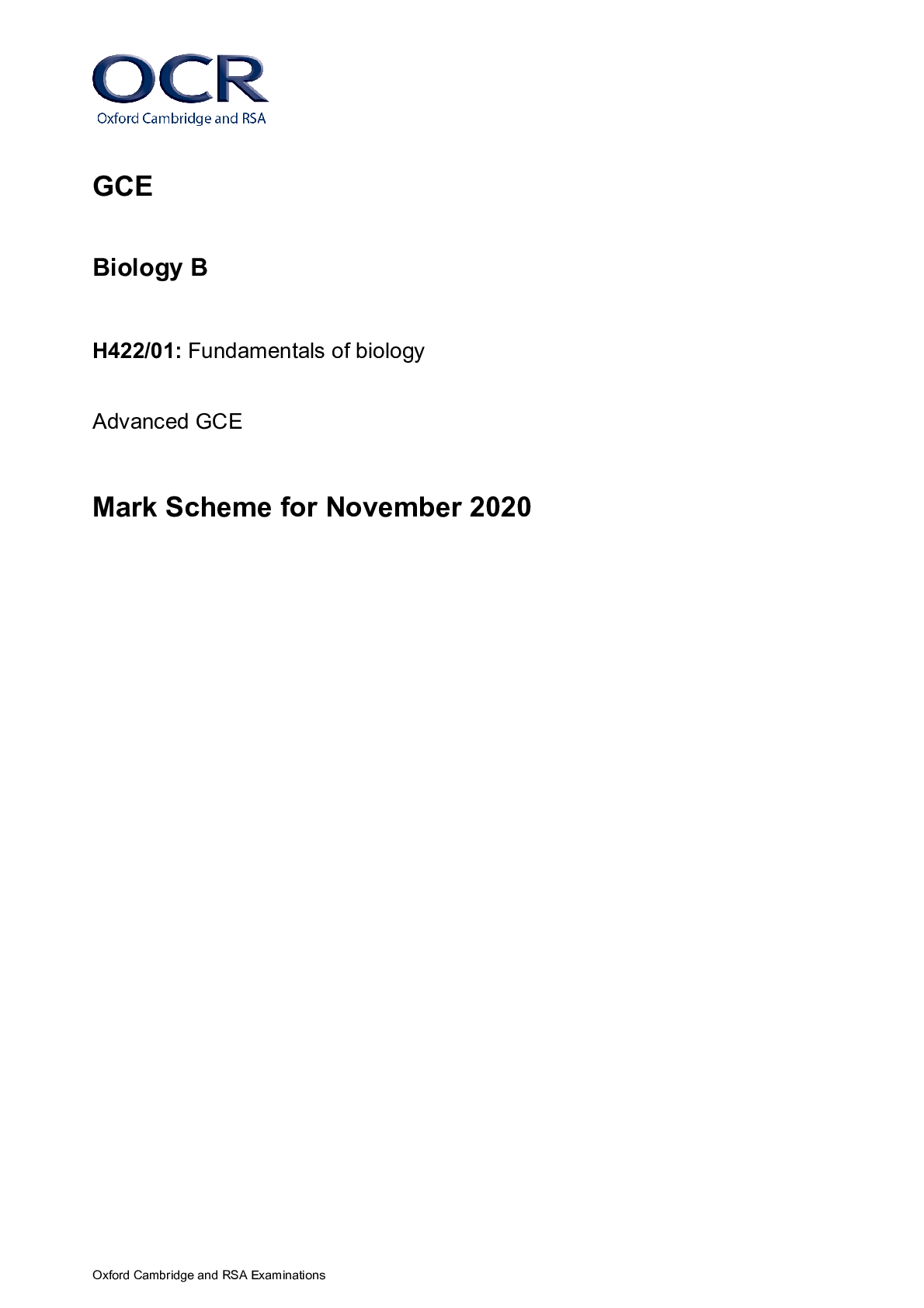

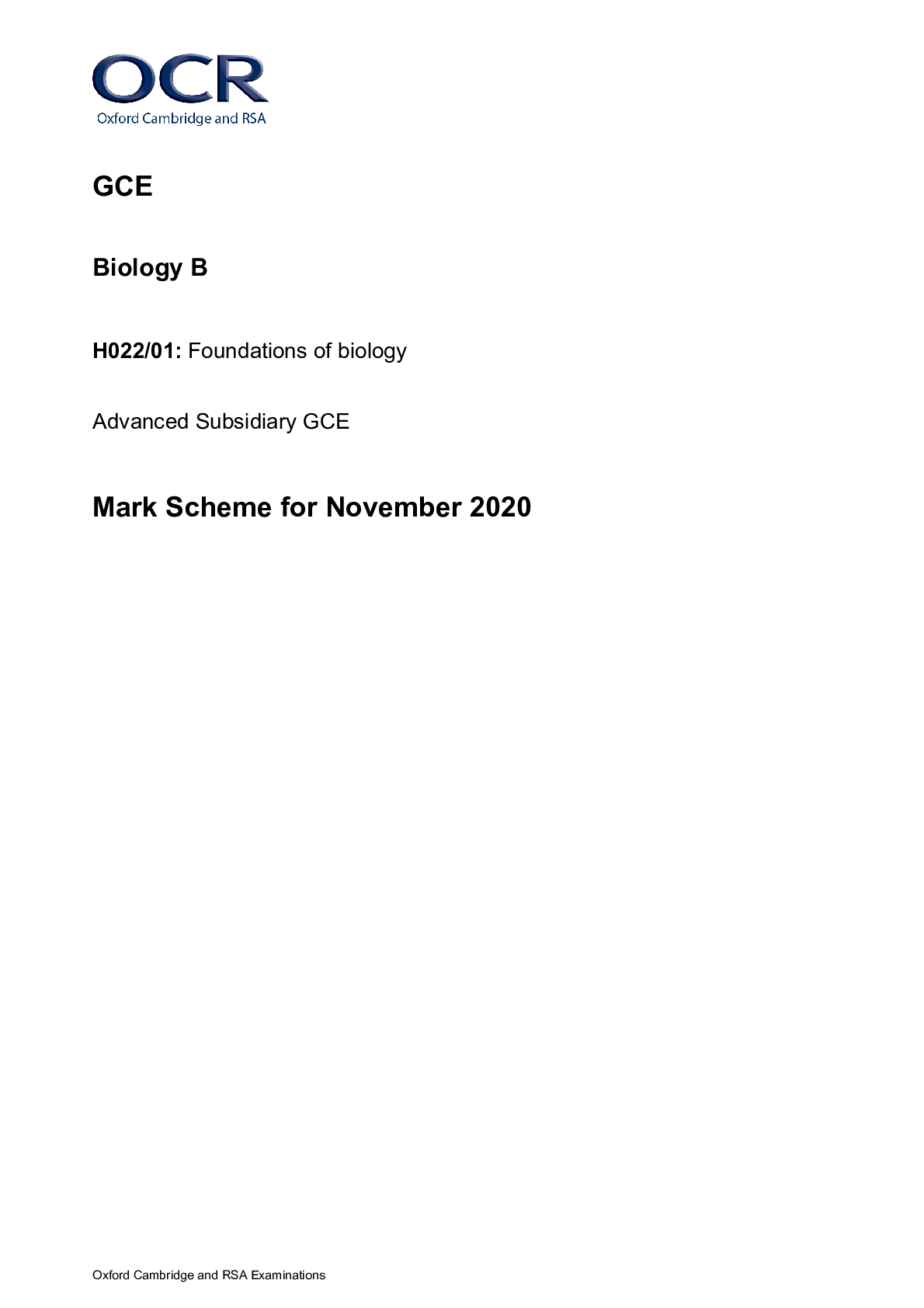
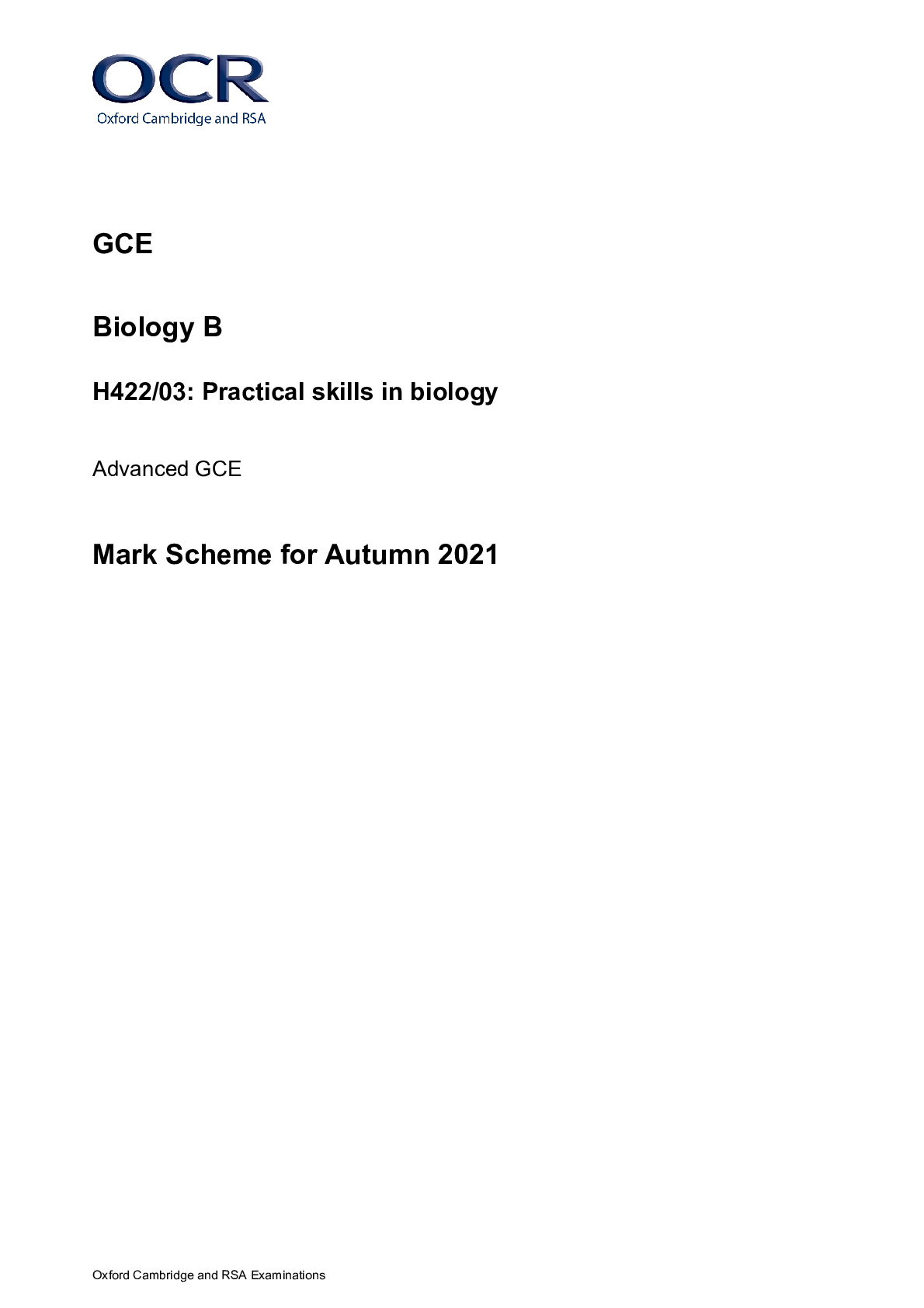
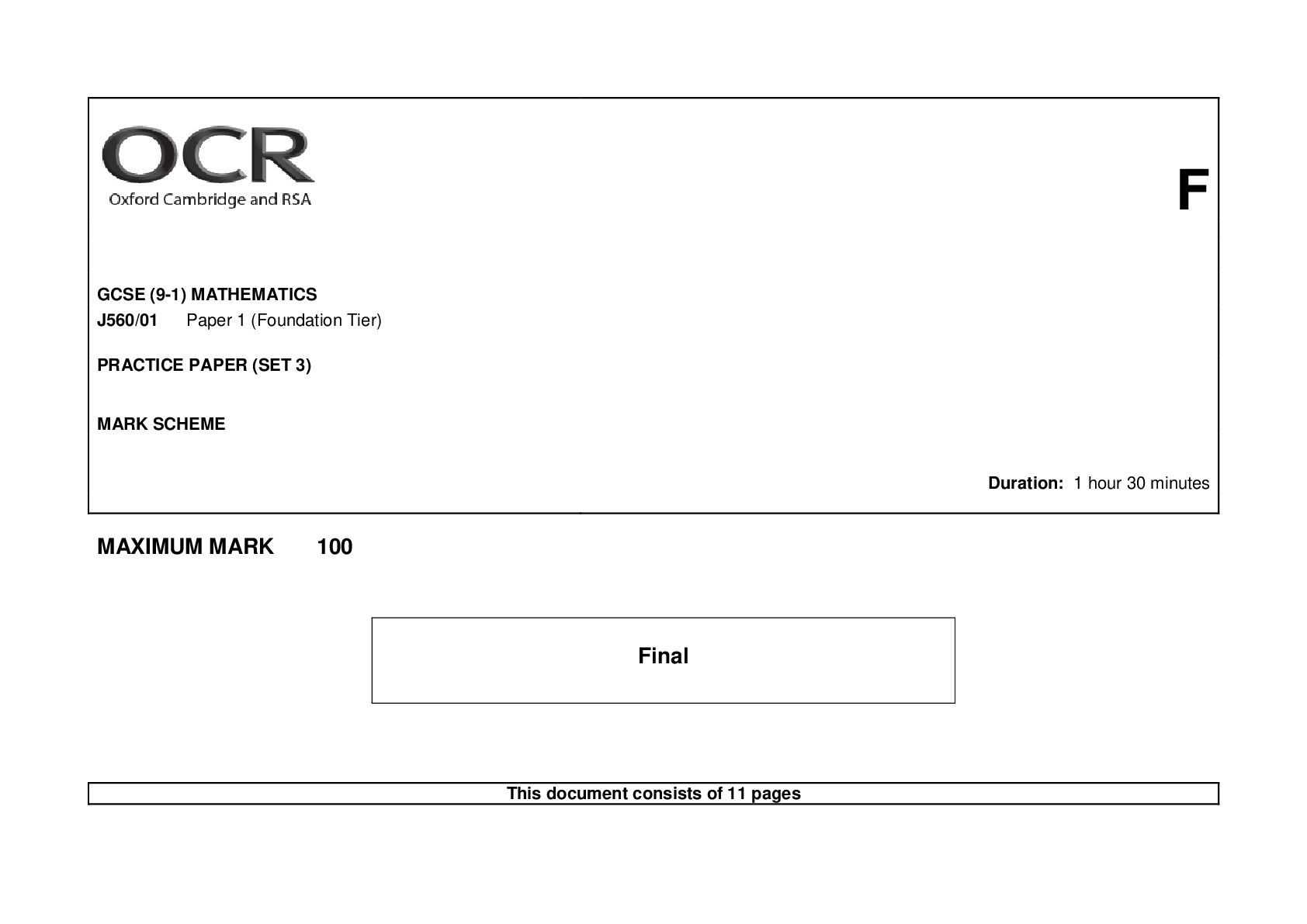
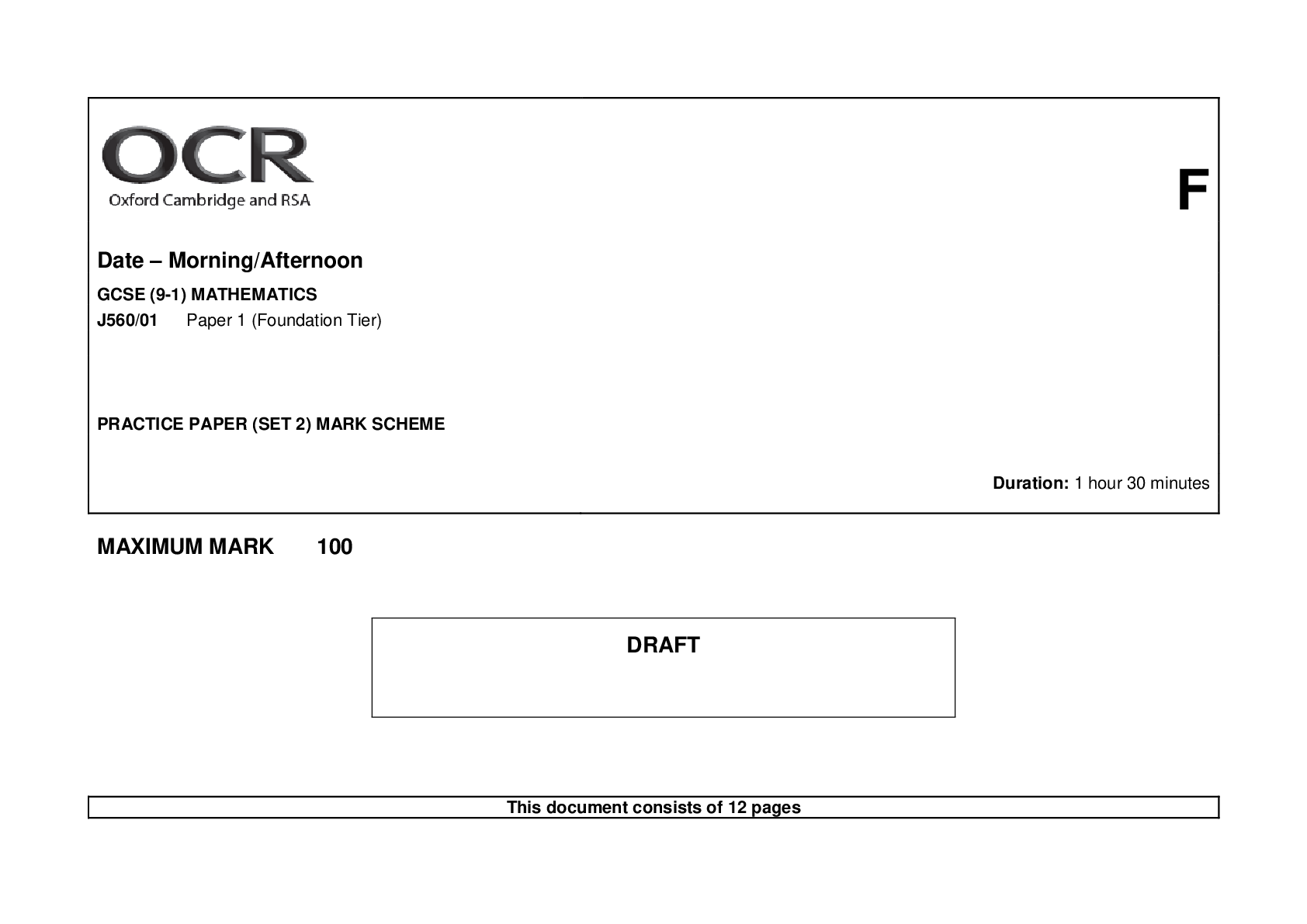
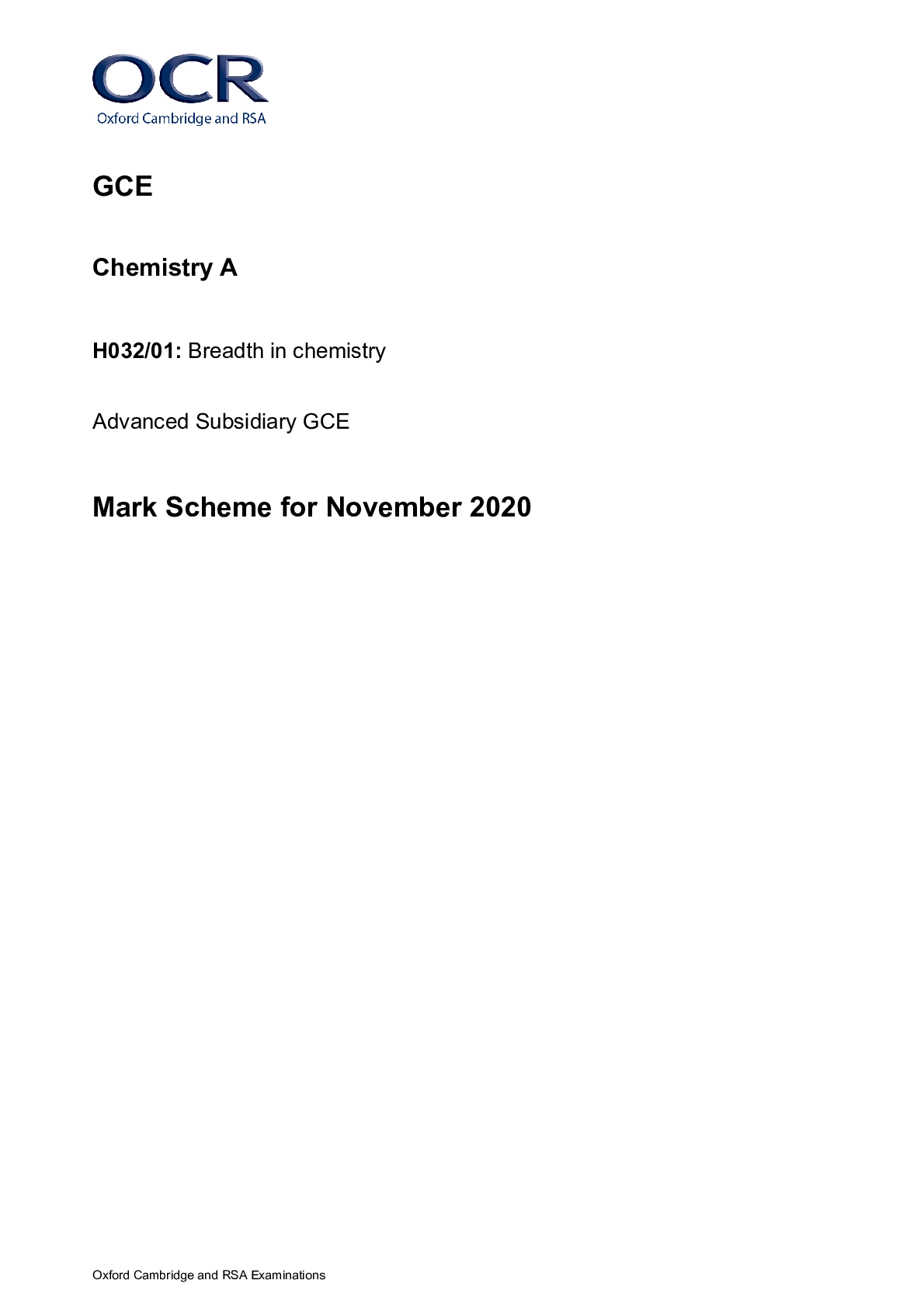

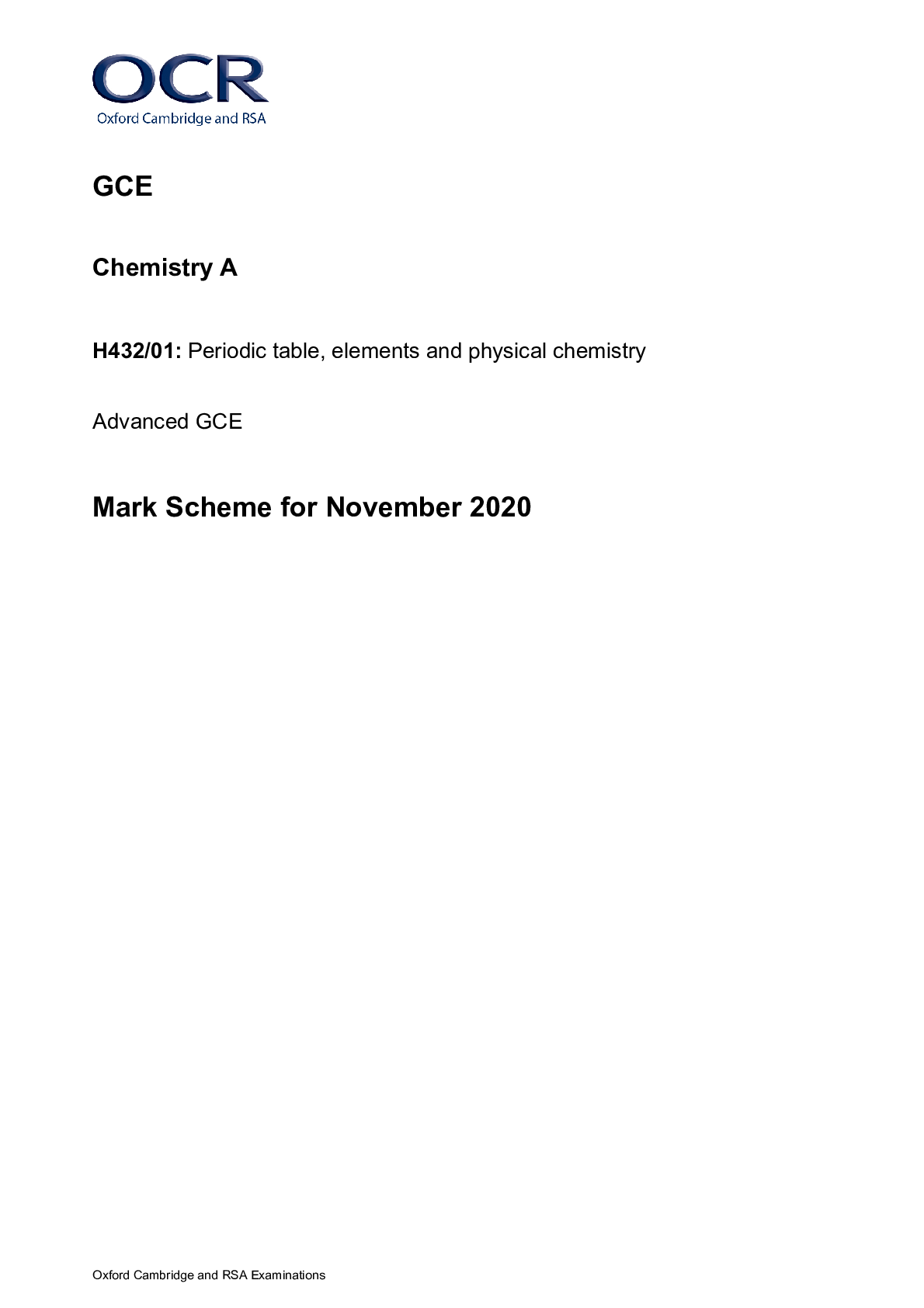
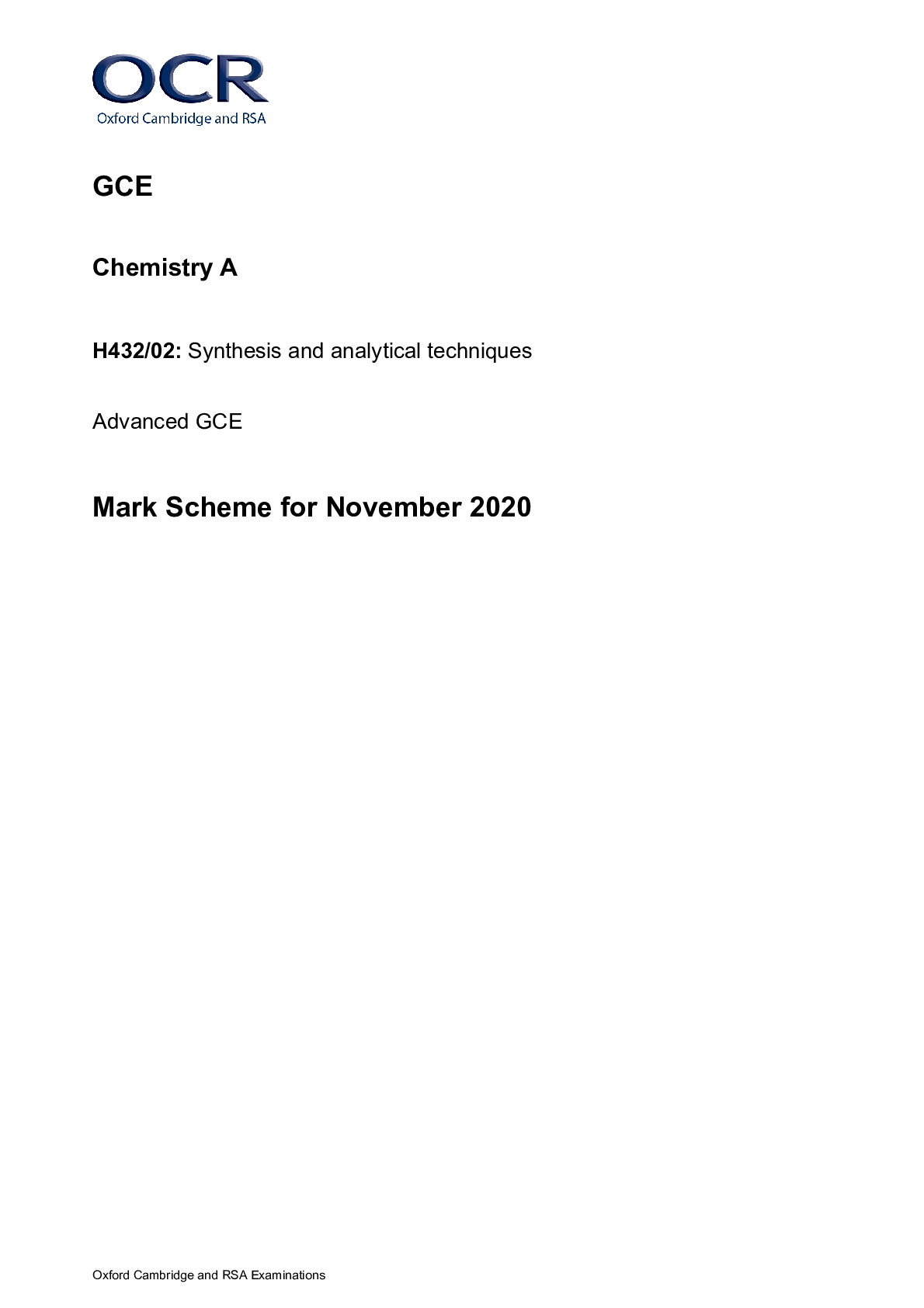

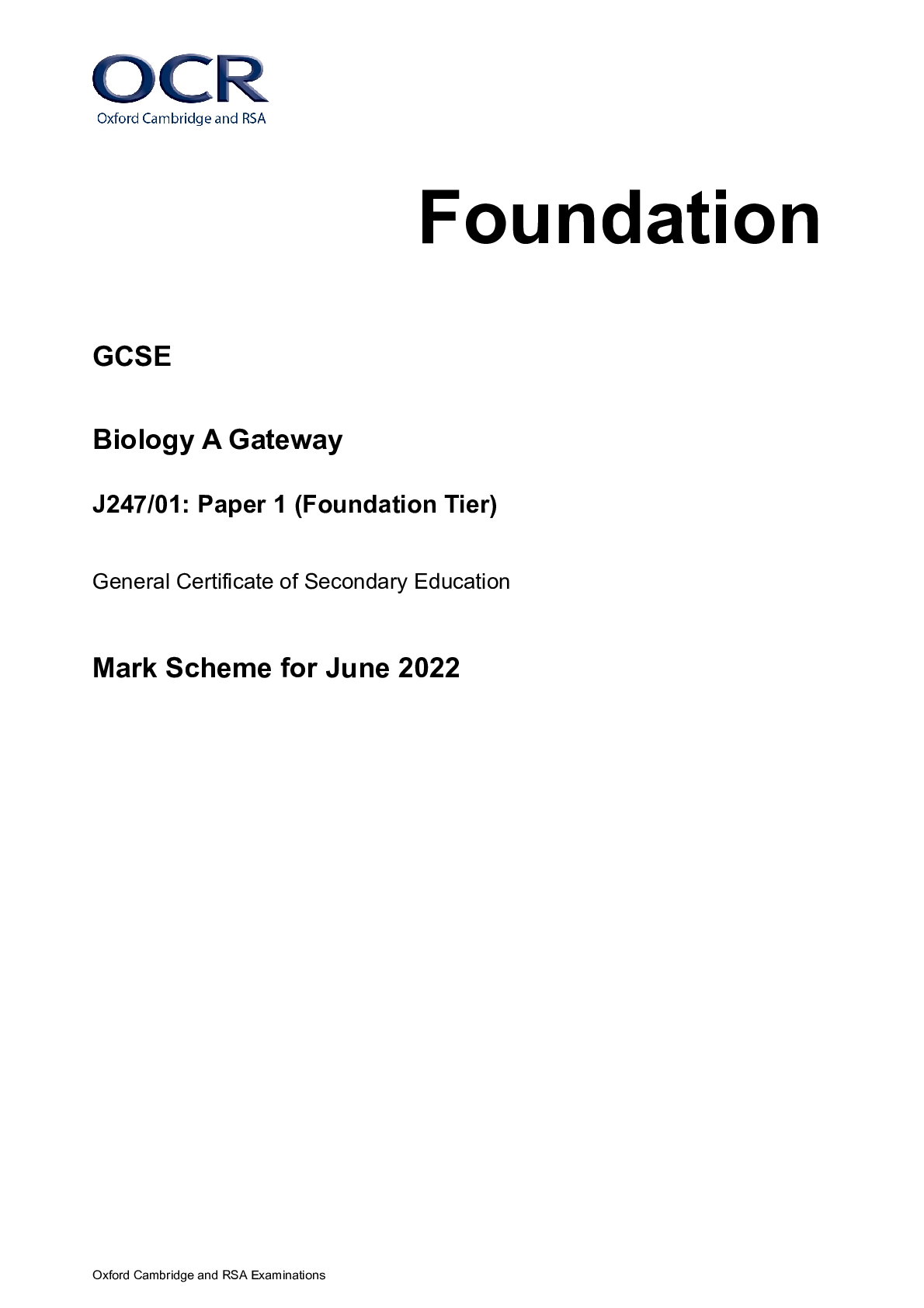
H630-02 Pure Mathematics and Statistics Advanced Subsidiary GCE Mark Scheme for Autumn 2021.png)

.png)


